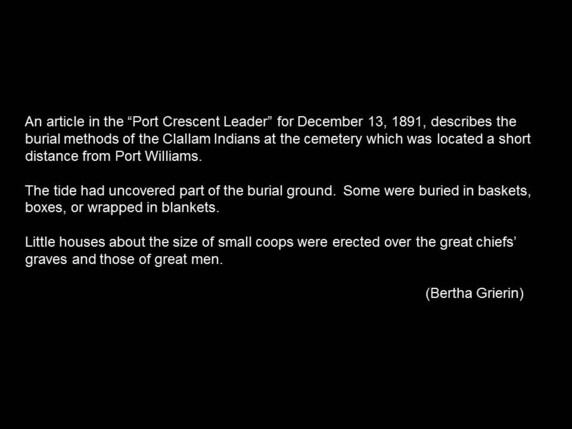By Jamie Valadez and Carmen Watson-Charles with additions from Tribal documents by Brenda Francis.
With the rediscovery of this Klallam village site č̕ixʷícən, which means inner harbor, comes an opportunity to learn more about the first people who lived in the area now known as Port Angeles.
Some people think of artifacts as treasures, but the Klallam people have a different perspective of what artifact means to them. These artifacts are belongings of their ancestors.
When someone died, their most special belongings were usually buried with them. When human remains were uncovered, the artifacts that were found in the burials will stay with them forever. However, there are many artifacts found that show how the Klallam people lived.
The village site, č̕ixʷícən, is unique because the artifacts found at this site are primarily rock and bone artifacts.
Many of the artifacts show a culture of fishing, hunting and trading. There are also artifacts that show unique ceremonial and burial practices, just as the oral Klallam
history shares.
The more than 64,000 artifacts discovered at the site have challenged some misinformation about the Klallam and led to the rediscovery of tribal traditions that had been buried with č̕ixʷícən.
For example, tribal members erroneously believed that their ancestors did not follow practices held by other Indian tribes, such as using traditional medicines or wearing red ocher to invoke spiritual protection. Artifacts from č̕ixʷícən disproved this and demonstrated that these practices belong to the Klallam as well. For instance, many burial boxes that were unearthed were covered with red ocher dust to protect the spirit of the departed.
Knowledge of other traditional practices had been lost throughout time as well. More than 906 etched stones were among the amazing collection of artifacts collected at the site during restoration. Delicate lines etched onto each stone tell a story; the carvings explain sacred teachings and may have been a way to pass teachings on to future generations. When the stones were initially discovered, knowledge of this practice had been lost and tribal members did not know what the stones were. These and many other artifacts are helping the Klallam people gain a better understanding of the ancestors and their life at č̕ixʷícən.
The cultural materials from č̕ixʷícən that have been radiocarbon-dated tell us that this village existed over 2,700 years, and as recently as the 1930’s. This documents that the Klallam people lived in this area in 300 BC.
There are many artifacts found at č̕ixʷícən that show how the Klallam people lived.
ʔáwkʷ ʔaʔ cə sčiʔúʔisɬ
Belongings of Our Ancestors

